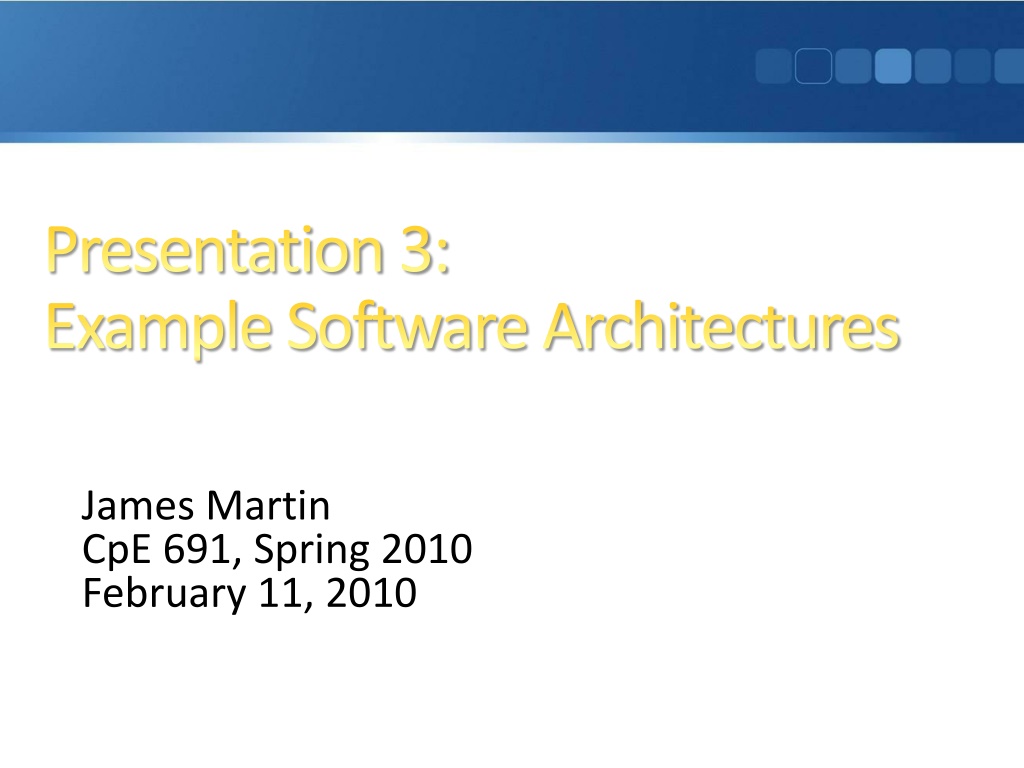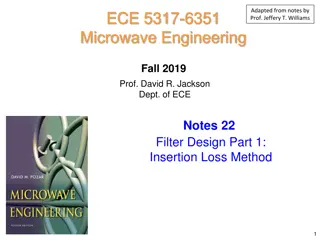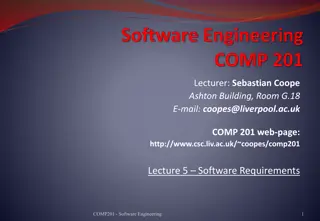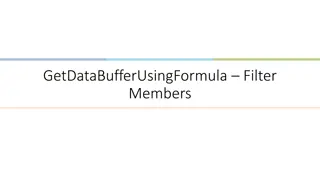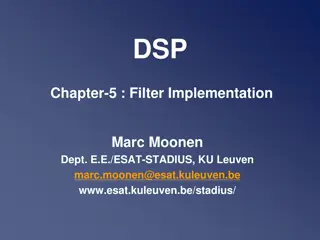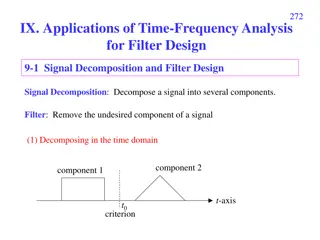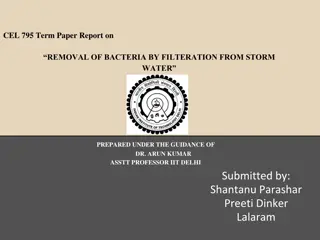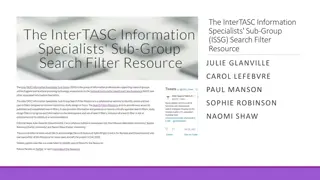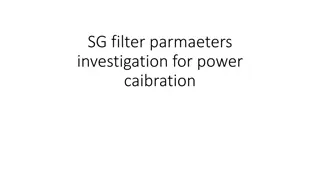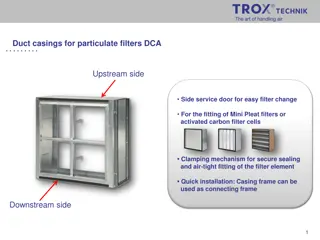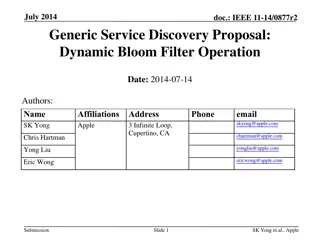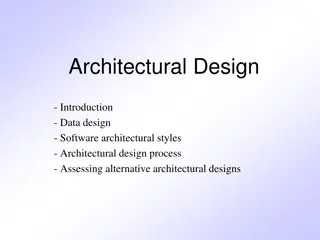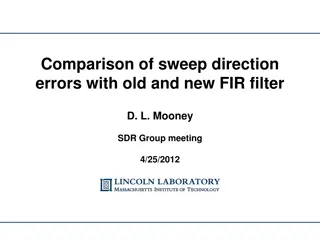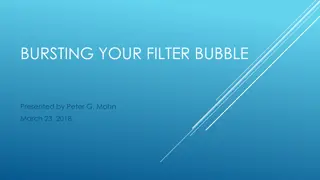Software Architecture Design for Document Filter System: A Case Study
This presentation delves into the software architecture design and implementation of a Document Filter System (DFS) aimed at efficiently finding relevant information. It discusses the architecture's effectiveness in supporting diverse applications, multilingual document searching, complex query functions, and document parsing for varied formats like PDF, TXT, DOC, and HTML. The DFS goals center on user-friendly operations and catering to researchers from various disciplines. The comparison with a Reference Architecture for E-Government highlights the specific attributes and functionality emphasis of each system.
Download Presentation

Please find below an Image/Link to download the presentation.
The content on the website is provided AS IS for your information and personal use only. It may not be sold, licensed, or shared on other websites without obtaining consent from the author. Download presentation by click this link. If you encounter any issues during the download, it is possible that the publisher has removed the file from their server.
E N D
Presentation Transcript
Presentation 3: Example Software Architectures James Martin CpE 691, Spring 2010 February 11, 2010
Projects Document Filter System (DFS) G. Zhao, D. Liu, H. Song, and C. Zou, Software architecture design and implementation of document filter system," Computational Intelligence and Natural Computing, International Conference on, vol. 1, pp. 309{312, 2009. [Online]. Available: http://dx.doi.org/http://doi.ieeecomputersociety.org/10.1109/CINC.2009.143 Reference Architecture for E-Government (RAfEG) D. Beer, R. Kunis, and G. Runger, A component based software architecture for e- government applications, Availability, Reliability and Security, International Conference on, vol. 0, pp. 1004 1011, 2006. [Online]. Available: http://dx.doi.org/http://doi.ieeecomputersociety.org/10.1109/ARES.2006.3
What to expect DFS Decent job of describing a software architecture at varying levels Lacks detail RAfEG Emphasizes the domain specific attributes / functionality of the application Only provides a top level software architecture Does not emphasize architecture
Projects Document Filter System (DFS) G. Zhao, D. Liu, H. Song, and C. Zou, Software architecture design and implementation of document filter system," Computational Intelligence and Natural Computing, International Conference on, vol. 1, pp. 309{312, 2009. [Online]. Available: http://dx.doi.org/http://doi.ieeecomputersociety.org/10.1109/CINC.2009.143 Reference Architecture for E-Government (RAfEG) D. Beer, R. Kunis, and G. Runger, A component based software architecture for e- government applications, Availability, Reliability and Security, International Conference on, vol. 0, pp. 1004 1011, 2006. [Online]. Available: http://dx.doi.org/http://doi.ieeecomputersociety.org/10.1109/ARES.2006.3
DFS Problem How to find interesting information or documents fast for a user has been a hot problem needed to be solved researchers have proposed lots of good algorithms and solutions; however, what we see these just implementing some function, or some models and it is not the whole system framework. There is not a friendly application system for filtering documents with the whole system architecture.
DFS Goals / Requirements Support different researchers application in different disciplines. Support searching operations for Chinese and English documents. Support complex query function with muticonditions. Support the parsing for different type of documents, such as PDF, TXT, DOC, and HTML etc. Convenient to operate for users.
DFS Goals / Requirements (2) Multiplicity: Supports each kind of documents; Flexibility: Supports the combination during searching Universality: Suits each kind of different crowd to use Friendliness: Provides the historical record and also
DFS System Level Pattern Model / View / Controller (MVC) Did not give any rational for using this pattern
System Architecture Design Top-layer use case diagram User is the only participant User can perform registration, login, information import and information inquiry Information import involves importing documents, parsing documents and inputing query information There are two types of information inquiries: advanced and regular
DFS Top Level Modules Simple list of classes Class User: class for the user Class DocumentParse: class for file parsing Class DataBaseObject: class for operating database Class PublicOperation: class for the public operation Class QueryRequest: class for requiring
DFS Database Design Only a list of tables was given
DFS -Implementation Languages: Java and C++ Tooling: Eclipse Searching: Apache Lucene PDF Import: PDF Box HTML and RTF Import: Java Swing MS Word Import: Tm-extractor Database: Apache Derby 10.2
Projects Document Filter System (DFS) G. Zhao, D. Liu, H. Song, and C. Zou, Software architecture design and implementation of document filter system," Computational Intelligence and Natural Computing, International Conference on, vol. 1, pp. 309{312, 2009. [Online]. Available: http://dx.doi.org/http://doi.ieeecomputersociety.org/10.1109/CINC.2009.143 Reference Architecture for E-Government (RAfEG) D. Beer, R. Kunis, and G. Runger, A component based software architecture for e- government applications, Availability, Reliability and Security, International Conference on, vol. 0, pp. 1004 1011, 2006. [Online]. Available: http://dx.doi.org/http://doi.ieeecomputersociety.org/10.1109/ARES.2006.3
RAfEG -Problem Official procedures are associated with a lot of paperwork in many cases more than one employee is involved many official procedures are not restricted to a single authority, leading to the need for distributed execution A system is required that will allow for the sharing procedural tasks and the documents that go with them
RAfEG Goals / Requirements design of a suitable e-government solution based on workflows according to modern standards for open source software. Should be executable on all established operating systems Should be easy to expand and adapt Distribution of system components on heterogeneous platforms as well as the distributed execution of official procedures should be possible
RAfEG -Goals / Requirements (2) Security features should allow a highly secure system by using up-to-date security software solutions and protocols Nonelectronic communication should be supported Various output formats like HTML pages, PDF documents and WML (Wireless Markup Language) pages should be supported New output formats should be easy to add Third party software should be free and easily exchangeable
RAfEG Core System Components Kernel Component Workflow Management Component Communication Component Presentation Component
RAfEG -Kernel Component Performs Authentication Authorization Logging Document Management Workflow Management
RAfEG -Workflow Management Component Provisions methods to access worklists Integrate new procedures modeled as workflows and updates existing ones Start workflows Accepts, executes and completes tasks by employees
RAfEG -Communication Component Manages communication between Multiple RAfEG core systems RAfEG and other governmental systems Allows for nonelectronic communication (extraction, import)
RAfEG Other Components Presentation Components: Handles dynamic generation of the user interface Frontend Components: provider interactive web-based user interface Backend Components: User management GIS map services Document management Database
